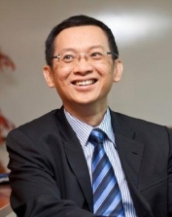新加坡国立大学力学工程系教授Tong Earn TAY学术报告会
日期:2022-11-10 00:00:00
报告题目:Adaptive Multi-Scale & Multi-Fidelity Progressive Failure Analysis of Composites
报告时间:2022年11月14日(周一) 下午15:00-16:00
报告地点:建筑工程学院8#202;#腾讯会议:117-163-156
报告人:Tong Earn TAY
报告人单位:新加坡国立大学力学工程系
报告人简介:
 Dr. Tong Earn TAY is a Professor at the Department of Mechanical Engineering, National University of Singapore (NUS). He has a PhD in Solid Mechanics from the University of Melbourne, Australia.
Dr. Tong Earn TAY is a Professor at the Department of Mechanical Engineering, National University of Singapore (NUS). He has a PhD in Solid Mechanics from the University of Melbourne, Australia.
His research interests are in progressive damage, failure, delamination, impact, and adaptive multi-fidelity and multi-scale computational analysis of fiber-reinforced composite materials and structures. He was previously Head of Department of Department of Mechanical Engineering, NUS, from 2011 to 2015, and Vice-Dean for Research for Faculty of Engineering, NUS, from 2009 to 2011. He is an associate editor for the Journal of Reinforced Plastics & Composites, and editorial board member of the Journal of Composite Materials, International Journal of Damage Mechanics, Applied Composite Materials, Multiscale and Multidisciplinary Modeling Experiment and Design, and Journal of Multiscale Modeling. He is a registered Professional Engineer (PE), Chartered Engineer (CEng), Founding Fellow of the Singapore Academy of Engineering (FSAE) and Council Member of the Asian-Australasian Association for Composite Materials.
报告摘要:Although high-fidelity modeling of progressive damage has advanced our understanding of failure mechanisms in fiber-reinforced composites, such techniques are currently still too computationally intensive for direct application to composites suggests that pertinent mechanisms could be interrogated at the appropriate length scale, where only active damage mechanisms and sites are explicitly modeled at the lower scale while inactive sites are represented by homogenized regions at the higher scale. In principle, this multi-fidelity and multi-scale approach may bridge mechanisms from micro- (fiber) to meso- (ply and tow) to macro- (structure) levels with potentially improved computational efficiency. This talk presents some recent developments of concurrent adaptive modeling strategies applied to progressive da-mage in composites. An adaptive discrete-smeared crack (ADiSC) method that combines the advantages of a discrete crack method (DCM) (high fidelity and explicit) and smeared crack method (SCM) (diffused damage and efficient) in a single model is described. This approach has been incorporated in an adaptive multi-fidelity (AMF) strategy, where shell elements are locally transitioned to brick elements (and vice versa), driven by the need for enhanced (or reduced) fidelity. Damage simulation with a concurrent micro-macro approach called the Direct FE2 (“finite element squared”) is under development; here the macroscale FE does not require homogenized constitutive properties because the required information is concurrently extracted from damage at the required information is concurrently extracted from damage at the microscale FE level. The talk concludes with discussion of future possibilities and applications of multi-fidelity modeling of composites.
邀请单位:黄淮学院建筑工程学院









